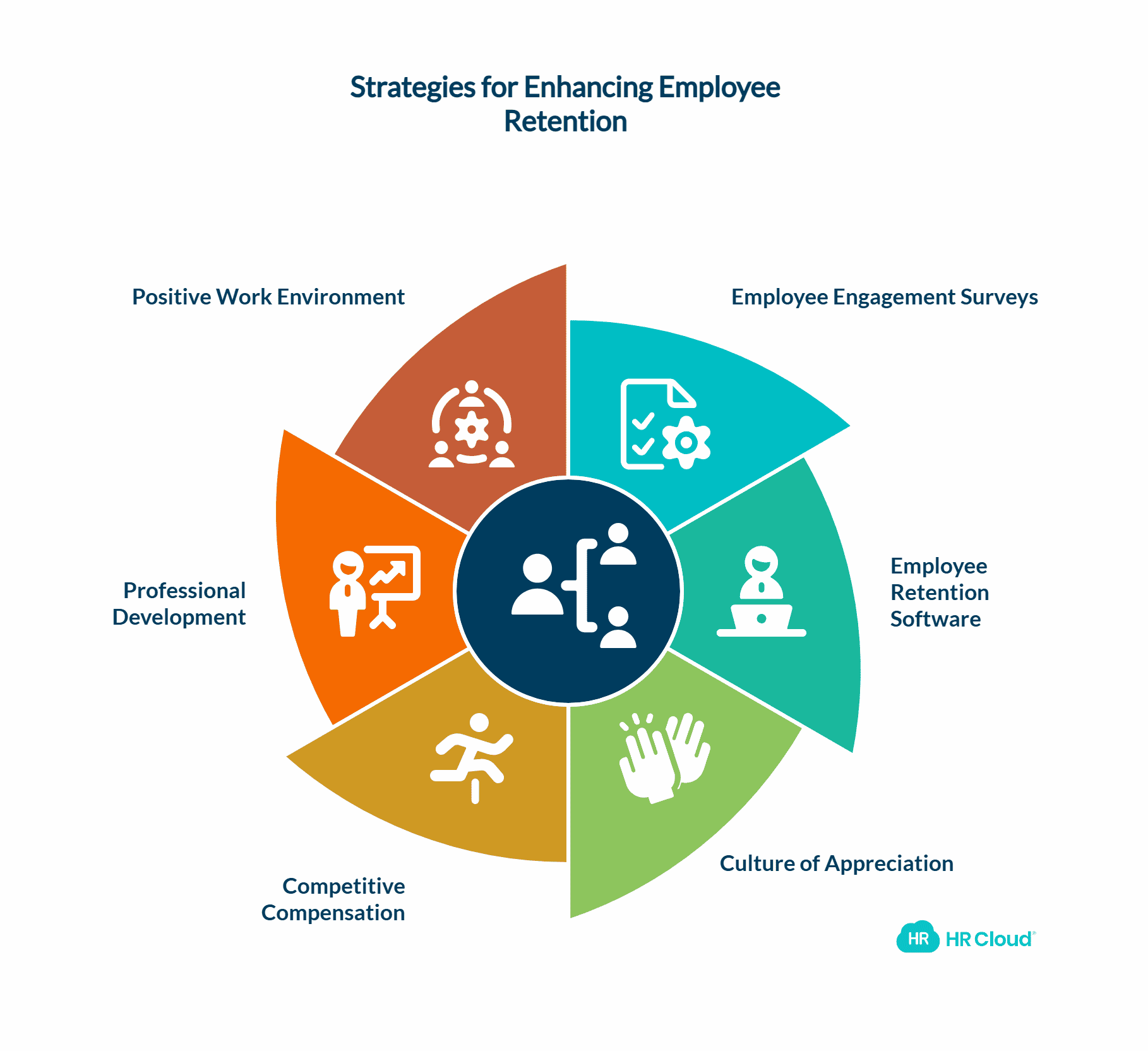From Turnover to Tenure: The Top Strategies for Improving Employee Retention in Manufacturing
-1.png)
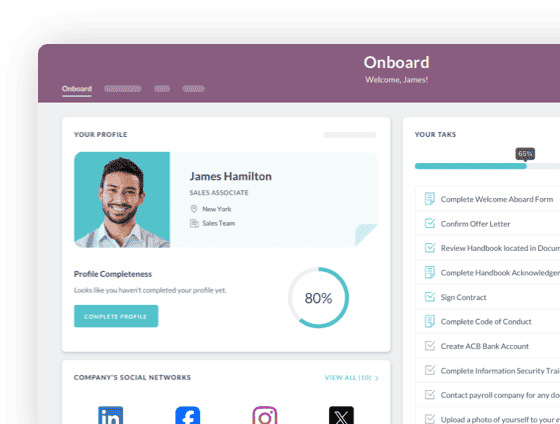
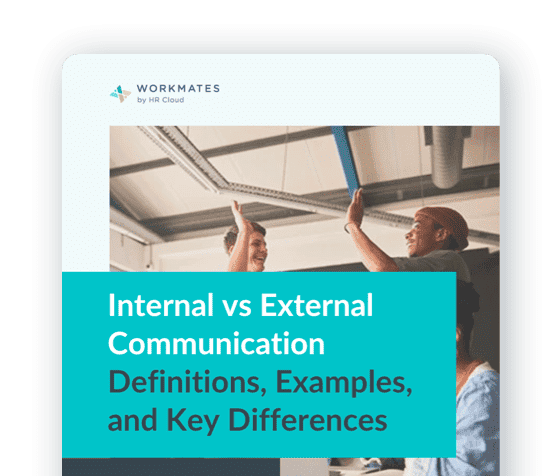
 Cut onboarding time
by 60%—here's the
Ultimate Checklist
that helped do it.
Cut onboarding time
by 60%—here's the
Ultimate Checklist
that helped do it.
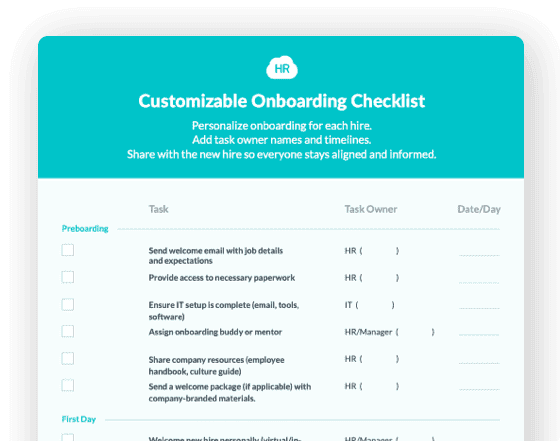
Employee retention is a critical factor in the success of any business, particularly in the manufacturing sector. Manufacturing companies face unique challenges with employee retention due to high demand as well as higher competition for skilled workers.
In this article, we will examine the importance of employee retention in manufacturing, the common reasons for higher turnover rates, and top strategies for retaining key talent in this field. Effective workforce management and retention strategies are essential for manufacturing companies to remain competitive and thrive in today's fast-paced business environment where many companies opt for shifting production capacity to Mexico or similar countries with lower production costs.
Manufacturing companies can become competitive by creating a positive workplace culture through Workmates, an innovative employee engagement software that focuses on improving the overall employee experience.
The Importance of Employee Retention in Manufacturing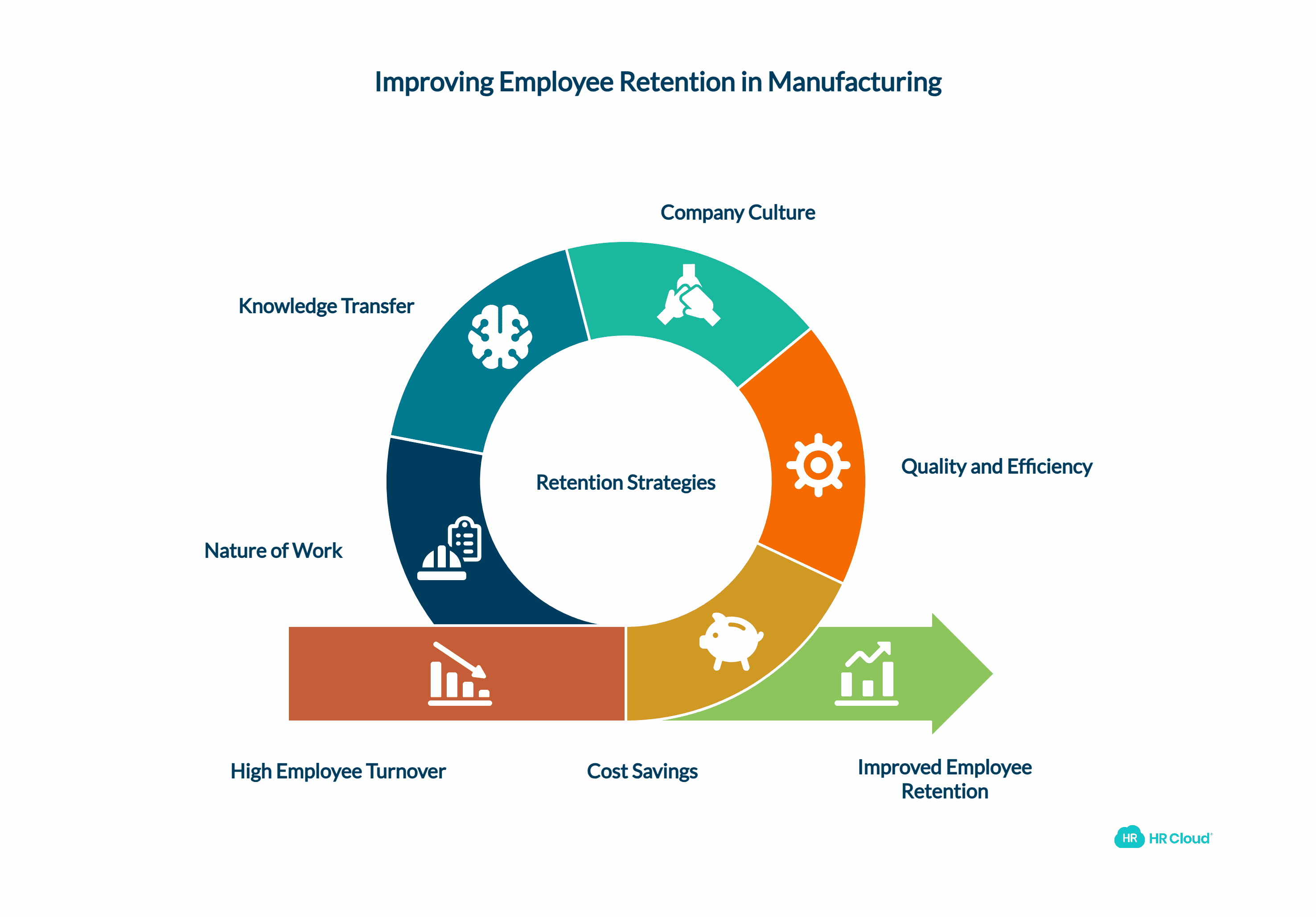
Focusing on employee retention and turnover in the manufacturing industry is crucial since repeated recruitment and training of new employees leads to a financial burden. Furthermore, high employee turnover rates can adversely affect both the productivity and the quality of the manufactured products. Here are some of the key retention drivers why retaining talent important in the manufacturing sector:
Cost savings: Hiring and training new employees can be expensive and time-consuming. Retaining skilled and experienced employees can save a company a significant amount of money in recruitment and training costs.
Quality and efficiency: Experienced employees are often more efficient and produce higher-quality work than new hires. Using strategies to retain top performers can lead to better production processes, fewer errors, and improved overall performance.
Company culture: Employee turnover can negatively impact company culture, as it can create uncertainty and instability in the workplace. By implementing effective retention strategies, manufacturing companies can build a strong culture of loyalty and teamwork, which can improve employee morale and foster an inclusive workplace.
Knowledge transfer: Skilled workers share specialized expertise and knowledge that can be challenging to replace. Retaining these employees ensures that their knowledge and experience remain within the company, which can be crucial for long-term success and effective talent management.
Nature of Work: The manufacturing sector has a unique challenge in retaining employees due to the nature of the work. The work can be physically demanding, repetitive, and monotonous, leading to employee burnout and dissatisfaction. It is therefore key for manufacturing companies to prioritize employee retention and workplace safety to achieve success in their overall business strategy.
Common Reasons for High Turnover in the Manufacturing Industry
There are several reasons for high turnover rates in the manufacturing industry. One of the primary reasons is a lack of engagement and motivation among employees. When employees feel disconnected from their work or do not feel valued, they are more likely to look for employment elsewhere.
Another reason for high turnover rates is the lack of opportunities for career growth and development. Employees who feel they have limited career growth opportunities are more likely to leave. Additional factors that contribute to high turnover rates include poor compensation, inadequate work-life balance, and a negative workplace culture. Conducting exit interviews can provide valuable insights into these issues and help improve retention rates.
Average Employee Turnover Rates by Industry
By the end of 2021, as the pandemic abated, organizations worked towards hybrid work setups, telecommuting, and safe health protocols. These improvements resulted in a decreased rate of turnover. However, the turnover rate accounts for every worker who left in the same year due to retirement, termination, or discharge. Upon closer inspection of voluntary resignations, however, 2021 boasts a record-breaking figure. An astounding 47.4 million individuals relinquished their jobs over the course of the year, a figure that surpasses previous records. The average turnover rate was 47.2% and manufacturing specifically recorded a 39.9% turnover rate in 2021.
According to the 2020 Retention Report from Work Institute, the resignation of every employee could lead to losses that account for one-third of their annual salary. Furthermore, high turnover rates can dampen the morale of the remaining staff, compounding the issue at hand. Manufacturing is among the top five industries with the highest turnover rates and here are some of the reasons:
-
Workers in this industry were unable to work from home like in other industries.
-
Workers continued going into the workplace to perform demanding work during stressful times.
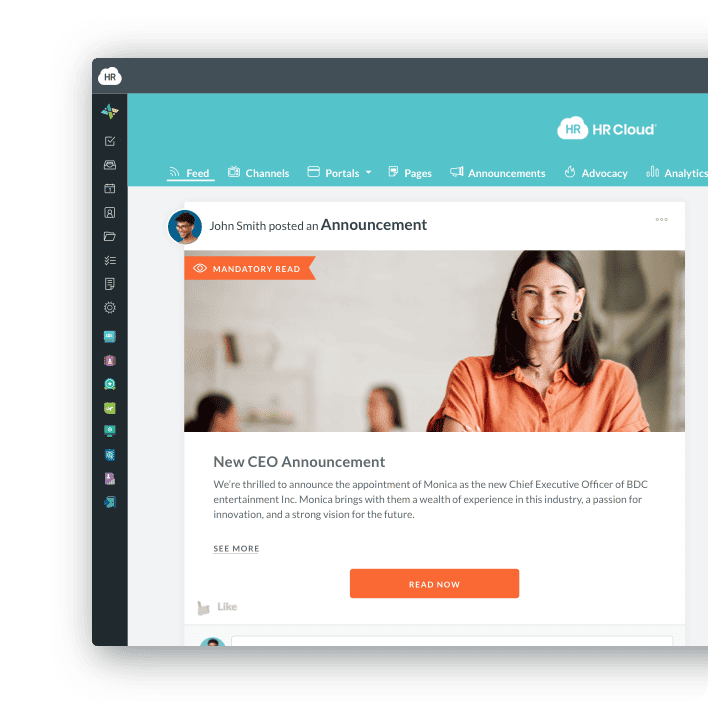
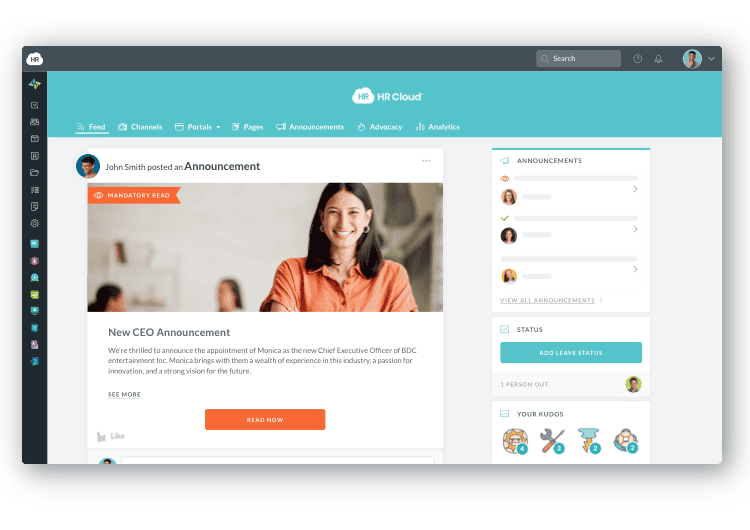
Benefits of Higher Employee Retention
Higher employee retention in manufacturing can have numerous benefits for the company. Some potential benefits include increased productivity, lower absenteeism rates, cost savings, and a more positive work environment.
When employees stay with a company for a longer period, they become more efficient and effective in their jobs. This increased efficiency can lead to increased productivity and cost savings for the company. Additionally, when employees are engaged, it can create a positive work environment, improved morale, and better customer satisfaction. Effective retention strategies can help in retaining top talent and reducing employee turnover, leading to a more stable and productive workforce.
Conducting Employee Engagement Surveys
One way to improve employee retention is to conduct employee engagement surveys. These surveys can help identify areas where employees feel disengaged, undervalued, or unappreciated. The survey can also provide insight into what motivates employees and what they value in their work. Once the survey is complete, management can analyze the results and create a plan to address the areas of concern. This includes implementing new policies to improve employee engagement, employee recognition, and appreciation. Using Workmates to conduct employee surveys can have several benefits, including:
Familiarity: Workmates is the right solution that is in tune with the organization's employees, culture, and work environment. This employee engagement tool makes it easier for organizations to connect with employees and gain their trust, which can result in more honest and accurate feedback.
Cost-effective: Using Workmates to conduct surveys is more cost-effective than hiring an external consultant. This can be especially beneficial for smaller manufacturing organizations with limited budgets.
Timely feedback: Workmates can gather feedback quickly and efficiently, and help in addressing any issues or concerns raised by employees in a timely manner.
Better response rates: Employees are more likely to participate in an anonymous survey through a familiar software such as Workmates. This can result in higher response rates and more representative data.
Actionable insights: Workmates can use the knowledge of the organization to interpret the survey results and provide actionable insights to management. This can help the organization identify areas for improvement and develop targeted engagement strategies to enhance employee engagement and satisfaction
Using Employee Retention Software to Improve Retention
Another effective way to improve employee retention is to use employee retention software. This software can provide real-time feedback on employee engagement levels and can help identify areas where employees are not properly engaged.
The software can also provide tools for managers to create action plans and address areas of concern. Workmates is an all-in-one Employee Engagement Software (EES) solution that offers effective employee engagement and surveys. It offers several benefits, including:
Increased adoption: Workmates can help to promote and drive the adoption of the EES among employees. As employees will already be familiar with the software, they can explain the benefits of the software to their colleagues and encourage participation.
Better data accuracy: Workmates is an effective employee engagement portal that can ensure the accuracy of the data collected as well as monitor responses. This can result in more reliable data that can be used to make informed decisions.
Improved communication: Workmates can use the EES to facilitate communication between the employees of a company and its management. This can help to build trust and transparency, as well as create a more collaborative work environment.
Personalized insights: Workmates is an employee engagement platform that provides personalized insights to employees based on their responses. This can help employees to better understand their strengths and weaknesses, and identify areas for improvement.
Enhanced engagement: Using an EES can help to increase employee engagement by providing opportunities for feedback, recognition, and development. Workmates is a popular Employee engagement survey tool that can facilitate this process by encouraging participation and promoting the benefits of the software.
Creating a Culture of Appreciation and Recognition
Creating a culture of appreciation and recognition can significantly improve employee retention. Organizations that make employees feel valued and appreciated can achieve long-term success. This can include implementing recognition programs, providing regular feedback, and offering opportunities for career growth. Additionally, creating a culture of appreciation and recognition can lead to a positive work environment and increased employee morale. This can lead to higher productivity and job satisfaction. Implementing peer recognition programs can further enhance this culture of appreciation.
Offering Competitive Compensation and Benefits
Providing reasonable yet competitive benefits and compensation is also essential for improving employee retention. Employees who feel they are being compensated fairly and have access to quality benefits are more likely to stay with a company long-term. This can include offering competitive salaries, health insurance, retirement plans, and other benefits. It is essential for manufacturing companies to regularly review their compensation and benefits packages and make adjustments as necessary to remain competitive. Flexible work arrangements, where possible, can also be a valuable addition to the benefits package.
Providing Opportunities for Professional Development and Growth
Providing opportunities for professional development and growth is another effective retention strategy. Employees who feel they have opportunities for career development within their roles are more likely to stay with a company long-term. This can include providing training programs, offering mentorship programs, and providing opportunities for advancement within the company. It is essential for manufacturing companies to invest in their employees' growth and development to retain manufacturing workers and top talent. Leadership development programs can be particularly effective in nurturing future leaders within the organization.
Creating a Positive Work Environment and Company Culture
Creating a positive work environment and company culture is essential for improving employee retention. Employees who feel they are part of a positive work environment and nurturing work culture are more likely to stay with a company long-term. This can include fostering open communication, creating a supportive and collaborative work environment, and promoting work-life balance. Additionally, creating a positive work environment and company culture can lead to reduced turnover, increased employee morale, and improved productivity. Implementing diversity and inclusion initiatives can further enhance the workplace culture and employee relations.
Conclusion - Implementing a Comprehensive Strategy for Employee Retention in Manufacturing
In conclusion, employee retention is critical in the manufacturing industry. High turnover rates can lead to negative consequences such as loss of skilled labor, decreased productivity, and increased costs associated with hiring and training new employees. Manufacturing companies that prioritize employee retention are more likely to have a skilled and experienced workforce, increased productivity, and a positive company culture. By implementing the best employee retention strategies outlined in this article, manufacturing companies can attract and retain key talent in the manufacturing industry, leading to increased productivity, cost savings, and a more positive work environment.
Using Workmates, a quality recognition software to conduct employee engagement surveys can be a valuable tool for organizations looking to improve employee satisfaction, retention, and productivity. Overall, using Workmates Employee Engagement Software from HR Cloud helps organizations to enhance employee engagement, productivity, and retention through employee recognition. By leveraging the expertise and familiarity of Workmates, organizations can ensure the success of their EES implementation and maximize the benefits for both employees and management.
To further improve retention rates, companies should consider implementing continuous feedback mechanisms, conducting regular pulse surveys, and organizing milestone celebrations to recognize employee achievements. By focusing on these engagement metrics and consistently working on improving the employee experience, manufacturing companies can create a work environment that not only retains talent but also attracts top performers in the industry.

Keep Reading
45 Boss Day Messages That Actually Mean Something (2026 Guide)
When is Boss Day 2026? Mark your calendar for October 16, 2026 — the annual opportunity
Birthday Wishes for Coworkers: 50+ Messages That Build Workplace Connection
A coworker's birthday isn't just another calendar date—it's a meaningful opportunity to
Embracing Diversity: Recognizing Different Cultures in the Workplace
Workplaces today reflect the incredible diversity of the world around us. People bring
Like What You Hear?
We'd love to chat with you more about how HR Cloud® can support your business's HR needs. Book Your Free Demo

Build a Culture of Recognition. Boost Engagement. Guaranteed.
Workmates empowers employees to stay informed, connected, and appreciated—whether they’re on the front line, in the office, or remote. Recognition drives 12x higher engagement.Trusted by industry leaders in every sector




Cut Onboarding Costs by 60%.
Take the confusion and follow-ups out of onboarding with automated workflows, digital forms, and structured portals—so new hires ramp faster 3X quicker.Trusted by industry leaders in every sector





